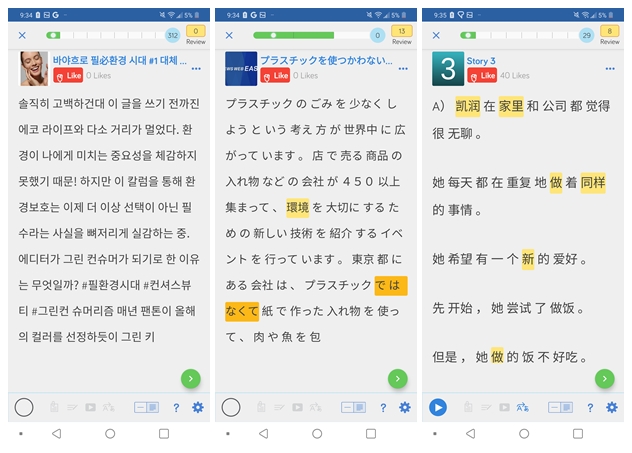Korean Vs Chinese Vs Japanese Writing
Korean vs Japanese vs Chinese, ever wonder what the similarities and differences are between these three languages and how should we go about learning them? To what extent can learning one help you with the others? Let me share my experience in learning these three Asian languages.
How I Learned Mandarin, Japanese and Korean
Mandarin Chinese: Intense and Structured
I spent almost a year studying Mandarin full time in Hong Kong. It was 1968 and I was a young Canadian diplomat (Canada was preparing to recognize the People's Republic of China).
My routine consisted of three hours of one-on-one tutoring with a Chinese teacher, five mornings a week. This was followed by four or five hours daily devoted to reading, listening, and learning characters. This took place in Hong Kong, which was not a place where Mandarin Chinese was spoken, especially not in those days. This was not an immersion environment.
It took me somewhat less than a year to reach a level where I could pass the British foreign service exam for Mandarin. This meant that I could read at quite a high level, books, newspapers and the like. For our exam, we were required to translate newspaper editorials from English to Chinese and from Chinese to English, as well as compose a diplomatic note in Chinese. Here you can read a post about "How to learn Chinese".
Japanese: Independent and Immersed
My experience with Japanese was different. I learned the language entirely on my own while living in Japan. I had the advantage of knowing Chinese characters, which are also used in Japanese where they are known as Kanji. I ended up living in Japan for nine years. Within a year of studying on my own, mostly listening and reading, I was able to start using Japanese with business contacts.
Over the nine years that I lived in Japan, my Japanese ability continued to improve. I used the language daily and took every opportunity to read and listen. Eventually I became a better speaker of Japanese than Chinese. My knowledge of Chinese was of considerable benefit in learning Japanese, as I will explain later.
Korean: A More Challenging Task
I have been studying Korean in Vancouver off and on for a few years. I mostly use LingQ. This means that I am on my own, as was my experience in learning Japanese, but I don't have the benefit of being immersed in the language.
Chinese Characters Are Key
With Chinese and Japanese reading presents an immediate problem. Until you have learned quite a few Chinese characters, you cannot read anything very interesting or meaningful.
While learning Chinese, I made a special effort to learn the most frequent 1,000 characters. I had paper flashcards for these. My learning strategy was to write these characters out on the squared exercise books that Chinese schoolchildren use.
I developed a primitive spaced repetition system, wherein I would write each new character out seven to 10 times, down the extreme left hand column of my exercise book. Then I would write the meaning or pronunciation three or four columns to the right. I would then pick up another flashcard and do the same, and a third and a fourth and so on. Soon I would run into the pronunciation, or English meaning, of the first character. I was forced to try to remember it, hopefully before I had completely forgotten it.
Whether I remembered the character or had to look it up, I then would write this first character out another five to seven times. Then I placed it a few columns to the right again. At first, I would continue this process for 10 new characters daily. I eventually increased the number of characters I studied daily to 30.
My retention rate was something less than 50%, perhaps closer to 30%. I would daily add back in characters previously studied. However, by doing this every day, the first thousand characters eventually more or less stuck with me. This was a good investment of my time, since I was able to use my knowledge of Chinese characters in my Japanese learning.
In some ways, Korean is the easiest of the three Asian languages to read, because the writing system is an alphabet. Korean is written in Hangul, an original and unique Korean phonetic script. At least 50% of the words, however, are clearly identifiable as being of Chinese origin.
Reading Complex Material
I like to read authentic material in a language in order to learn, newspapers, books and the like. To do this requires a fairly rich vocabulary. For Chinese, I needed between three and four thousand characters. I explained above how I learned the first thousand. Thereafter, I tended to learn new characters mostly from my reading and writing, writing them out a few times on a piece of paper. Of course, I continued forgetting them, but by forgetting, rewriting, relearning, and seeing them again in different contexts, eventually they started to stick.
As with much in language learning, things become easier as you progress. You start to recognize the different components of the characters that repeat in different combinations within the characters. When you first start out it seems like an impossible task to remember 10, 12, 13 or more different strokes for just one character. After a while you really start to enjoy the characters and how they express ideas and concepts.
No only do the components of the characters repeat, the characters themselves are used in a variety of combinations with each other to express what we consider to be words. Thus, once you have acquired a certain number of characters, it becomes easier to build up your vocabulary. With the characters that you know, you can often guess at the meaning of new combinations of characters that you encounter in your reading. Even if you guess wrong and need to learn a new compound word, it is easy to remember these new combinations because the characters themselves represent meaning.
The result of having invested the time in learning characters is that it is faster to build up a large vocabulary, and access more and more sophisticated texts than in some other languages I have studied. A knowledge of Chinese characters also helps in learning Japanese and Korean.

I enjoy reading meaningful authentic texts. In Japanese this means lots of Chinese characters or Kanji. In Korean it means texts with a high percentage of Chinese origin words. An initial problem for me with Japanese was that beginner texts are mostly written using Hiragana, the main Japanese phonetic alphabet.
Authentic Japanese content with a high percentage of Kanji was simply too difficult for me for quite a while. Therefore, I just persisted reading in Hiragana until my knowledge of Japanese improved. For the first few months I was sort of oblivious to the many Chinese origin words that I was reading. As soon as I could I progressed to authentic material with characters.
My knowledge of characters has helped in my study of Korean. When I study Korean at LingQ, I always include the Chinese character, or Hanja as they are called in Korean, in the meaning of the new Korean word that I save to my vocabulary database. I expect that Hanja will be reintroduced into the Korean education system in the future for a variety of reasons, not the least of which is the increasing importance of China, and the Chinese language.
I should point out that when I learned Chinese characters 50 years ago, I had to be able to write them out by hand in order to pass the British foreign service exam. I had no such obligation when I studied Japanese. For my practical needs, in daily life or in business, I only needed to be able to read, and speak. If I needed to write, I could use a computer based word processing system.
Today I can no longer write Chinese by hand. I can only write in all three languages by using a computer. Modern technology is a wonderful thing. I have to say I don't know if it is possible to learn Chinese characters without writing them out by hand.
Grammatical Structure
Language structure and word order in Chinese are easier than in Japanese or Korean for English speakers or speakers of European languages. The word order is very often more similar to what we're used to. What is more, unlike in many European languages, there are no tenses, case endings, agreements etc. to worry about.
Japanese and Korean have somewhat similar word order, and are vaguely related to the same language family, unlike Chinese. However, Korean and Japanese are sufficiently different to make it a challenge to move on to Korean after Japanese. Korean has proven more difficult for me than I expected.
Both Japanese and Korean have greater differences in levels of politeness than Chinese or European languages that I know. I found that I was able to stay with fairly neutral levels of politeness until I developed a natural sense of when I need to be more humble or more familiar in my choice of words.
If you want to learn more about grammar, LingQ now has free resources in Korean, Chinese, and Japanese.
Pronunciation
Pronunciation in Mandarin Chinese is difficult only because of the fact that there are four different tones. The tone determines the meaning of a word. In other words, whereas we use intonation for emphasis in English, Chinese uses tones for the meaning of each sound. If we ignore the problem with tones, the actual sounds themselves are quite similar to many sounds in English. It's not surprising that there are quite a few English speakers who are wonderful speakers of Chinese. One such person such as the famous Dashan, a Canadian who has become a famous personality on TV in China.
To master the tones, I found that I had to do a lot of listening in order to acquire the intonation and rhythm of the language. Trying to remember the individual tone for each word I learned was too difficult. Trying to think of the tones in each word made me to unsure of myself when I wanted to speak. One thing I found useful was to listen to 相声 (Xiang Sheng) comic dialogues in Chinese. Comedians exaggerate the intonation of a language, and by listening to them their rhythm can be infectious. If you can get the intonation and rhythm of a language, your ability to pronounce will improve.
Korean and Japanese are not tonal languages. I didn't find them difficult to pronounce. Acquiring correct pronunciation is, like listening comprehension, a function of how much time we put into listening, and developing the ability to notice how words are pronounced.

Korean vs Japanese vs Chinese
In summary, my strategy for learning all three languages was the same: lots of reading and listening, and eventually speaking whenever I had the chance. Learning the Chinese characters was a major investment of time, but one I am glad I made. Before my contact with Asian languages I perceived them as exotic, very different from what I was used to. Once I got into these languages, I found them fascinating and rewarding. They have become a familiar and enriching part of my life. I am most thankful that I had the opportunity to learn them.
Korean Vs Chinese Vs Japanese Writing
Source: https://blog.thelinguist.com/difference-chinese-japanese-korean/
Posted by: shaffershabligne.blogspot.com

0 Response to "Korean Vs Chinese Vs Japanese Writing"
Post a Comment